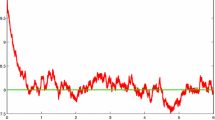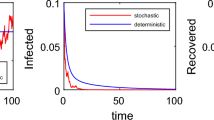Abstract
In this paper a stochastic susceptible-infectious (SI) epidemic model is analysed, which is based on the model proposed by Roberts and Saha (Appl Math Lett 12: 37–41, 1999), considering a hyperbolic type nonlinear incidence rate. Assuming the proportion of infected population varies with time, our new model is described by an ordinary differential equation, which is analogous to the equation that describes the double Allee effect. The limit of the solution of this equation (deterministic model) is found when time tends to infinity. Then, the asymptotic behaviour of a stochastic fluctuation due to the environmental variation in the coefficient of disease transmission is studied. Thus a stochastic differential equation (SDE) is obtained and the existence of a unique solution is proved. Moreover, the SDE is analysed through the associated Fokker–Planck equation to obtain the invariant measure when the proportion of the infected population reaches steady state. An explicit expression for invariant measure is found and we study some of its properties. The long time behaviour of deterministic and stochastic models are compared by simulations. According to our knowledge this incidence rate has not been previously used for this type of epidemic models.









Similar content being viewed by others
References
Busenberg S, Cooke K (1993) Vertically transmitted diseases: models and dynamics (biomathematics). Springer, Berlin
Capasso V (2008) Mathematical structures of epidemic systems, corrected 2nd printing. Lecture notes in Biomathematics, vol 97. Springer, Berlin
Capasso V, Bakstein D (2012) An introduction to continuous-time stochastic processes: theory, models, and applications to finance, biology, and medicine (modeling and simulation in science engineering and technology), 2nd edn. Birkhauser, Boston
Chen C, Kang Y (2014) Dynamics of a stochastic SIS epidemic model with saturated incidence. Abstr Appl Anal 2014:1–13
Das P, Mukherjee D, Sarkar AK (2011) Study of an S-I epidemic model with nonlinear incidence rate: discrete and stochastic version. Appl Math Comput 218(6):2509–2515
Ding Y, Xu M, Hu L (2008) Asymptotic behavior and stability of a stochastic model for AIDS transmission. Appl Math Comput 204(1):99–108
Ding Y, Xu M, Hu L (2009) Risk analysis for AIDS control based on a stochastic model with treatment rate. Hum Ecol Risk Assess Int J 15(4):765–777
Fan D, Wang K, Hong L (2009) The complete parameters analysis of the asymptotic behaviour of a logistic epidemic model with two stochastic perturbations. Math Probl Eng 2009:1–7
Getz WM (1996) A hypothesis regarding the abruptness of density dependence and the growth rate of populations. Ecology 77(7):2014–2026
González-Olivares E, González-Yañez B, Mena-Lorca J, Ramos-Jiliberto R (2007) Modelling the Alle effect: are the difference mathematical forms proposed equivalent? In: Proceedings of the international symposium on mathematical and computational biology, BIOMAT 2006, pp 53–71
González-Olivares E, González-Yañez B, Mena-Lorca J, Rojas-Palma A, Flores JD (2011) Consequences of double Allee effect on the number of limit cycles in a predator-prey model. Comput Math Appl 62(9):3449–3463
Gray A, Greenhalgh D, Hu L, Mao X, Pan J (2011) A stochastic differential equation SIS epidemic model. SIAM J Appl Math 71(3):876–902
Henderson D, Plaschko P (2006) Stochastic differential equations in science and engineering. World Scientific Pub Co Inc, Singapore
Hethcote HW (2000) The mathematics of infectious diseases. SIAM Rev 42(4):599–653
Hu G, Liu M, Wang K (2012a) The asymptotic behaviours of an epidemic model with two correlated stochastic perturbations. Appl Math Comput 218(21):10520–10532
Hu Z, Ma W, Ruan S (2012b) Analysis of SIR epidemic models with nonlinear incidence rate and treatment. Math Biosci 238(1):12–20
Kloeden PE, Platen E, Schurz H (1994) Numerical solution of SDE through computer experiments (universitext). Springer, Berlin
Lahrouz A, Omari L, Kiouach D (2011) Global analysis of a deterministic and stochastic nonlinear SIRS epidemic model. Nonlinear Anal Model Control 16(1):59–76
Liu M, Wu Q, Wang K (2012) Analysis of an improved epidemic model with stochastic disease transmission. Appl Math Comput 218(19):9750–9758
Liu Q, Chen Q (2016) Dynamics of a stochastic SIR epidemic model with saturated incidence. Appl Math Comput 282(may):155–166
Liu W, Hethcote HW, Levin SA (1987) Dynamical behavior of epidemiological models with nonlinear incidence rates. J Math Biol 25(4):359–380
Rao F (2014) Dynamics analysis of a stochastic SIR epidemic model. Abstr Appl Anal 2014:1–9
Rao F, Wang W, Li Z (2012) Stability analysis of an epidemic model with diffusion and stochastic perturbation. Commun Nonlinear Sci Numer Simul 17(6):2551–2563
Roberts MG, Saha AK (1999) The asymptotic behaviour of a logistic epidemic model with stochastic disease transmission. Appl Math Lett 12(1):37–41
Ruan S, Wang W (2003) Dynamical behavior of an epidemic model with a nonlinear incidence rate. J Differ Equ 188(1):135–163
Silverman BW (1986) Density estimation for statistics and data analysis. Chapman and Hall, London
Xiao D, Ruan S (2007) Global analysis of an epidemic model with nonmonotone incidence rate. Math Biosci 208(2):419–429
Xu R (2012) Global dynamics of an SEIS epidemic model with saturation incidence and latent period. Appl Math Comput 218(15):7927–7938
Zhou J, Hethcote HW (1994) Population size dependent incidence in models for diseases without immunity. J Math Biol 32(8):809–834
Acknowledgements
A.C. thanks for the partial support by Fondecyt Project 11160937. M.C. thanks the support from Centro Interdisciplinario de Estudios Atmosféricos y Astroestadística.
Author information
Authors and Affiliations
Corresponding author
Appendix
Appendix
1.1 Expression for \(P^{*}\)
Given \(Z\in [\epsilon ,1]\), \(\epsilon >0\), by replacing F(Z) and G(Z) in equation for \(P^{*}(Z)\) in Theorem 4.68 in Capasso and Bakstein (2012), we obtain
where \(K'\) is the normalizing constant, that is, \(\int \nolimits _{0}^{1} P^{*}(Z) dZ=1\), if \(P^{*}(Z)\) is integrable in [0, 1]. By splitting the integral in the exponent we can rewrite \(P^{*}(Z)\) by
where \(I_1=\frac{-2(1-p)B}{\rho ^2 C^2} \int \nolimits _{\epsilon }^{Z} \frac{(y+a)^2}{y^3 (1-y)^2} dy\), \(I_2=\frac{2q_0}{\rho ^2 C} \int \nolimits _{\epsilon }^{Z} \frac{(y+a)}{y^2 (1-y)} dy\) and \(I_3=\frac{-2\alpha }{\rho ^2 C^2} \int \nolimits _{\epsilon }^{Z} \frac{(y+a)^2}{y^3 (1-y)} dy\).
After solving the three integrals, we set
With algebraic manipulation over (17) and putting \(L=e^{\tilde{C}_1 +\tilde{C}_2 -\tilde{C}_3} K'\), we obtain (15).
Rights and permissions
About this article
Cite this article
Christen, A., Maulén-Yañez, M.A., González-Olivares, E. et al. Modeling a SI epidemic with stochastic transmission: hyperbolic incidence rate. J. Math. Biol. 76, 1005–1026 (2018). https://doi.org/10.1007/s00285-017-1162-1
Received:
Published:
Issue Date:
DOI: https://doi.org/10.1007/s00285-017-1162-1
Keywords
- Epidemic model
- Non linear incidence rates
- Stochastic transmission
- Stochastic differential equations
- Asymptotic behaviour




